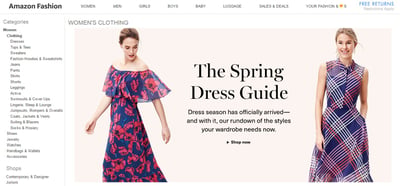While walking through the gardens at Hever Castle (Kent, Great Britain) imagining what is was like for the young Anne Boleyn to live there and get lost in the garden’s maze (long before the thought of marriage to King Henry VIII entered her mind), an investor called asking for my opinion on Cowen’s Internet analyst, John Blackledge’s prognostication in WWD that Amazon would surpass Macy’s as the number one seller of apparel by 2017.
The question rocketed me from the 16th century to the 21st. Amazon, which so mightily won the book and media market with low prices, endless aisles, and one-click shopping, was making serious inroads in the $215 billion apparel market.
Blackledge’s argument was the accelerating apparel purchaser growth Amazon was experiencing (+47% year over year according to Cowen’s Survey Data) with increased ecommerce adoption, the growing number of Amazon Prime members (Kantar Retail estimates 37% of US households are Prime members), and Amazon’s competitive advantages. In tandem with Amazon’s growing apparel sales, estimated by Cowen at $16 billion GMV (gross merchandise volume) in 2015, is the expanding list of national brands and specialty apparel retail brands willing to sell on Amazon’s Marketplace for access to Amazon’s customers, including Kate Spade, Fossil, Tumi, Tommy Hilfiger, Calvin Klein, Nike, and Abercrombie & Fitch, which become further fuel driving Amazon’s success. More brands attract more shoppers and Amazon’s win expands.
The US apparel market is highly fragmented (about 55% of industry sales are generated by the top 15 apparel industry participants), providing ample opportunity for Amazon to capture share. Blackledge saw Amazon’s 2017 share growing to 14% of the total apparel market, with 3P (third party) sales growing faster than 1P (Amazon-owned inventory).
At Shoptalk (a nextgen ecommerce and retail conference), we heard Amazon Marketplace VP, Peter Faricy urging small brands to join its Marketplace community and use it as a growth strategy. For Amazon, the Marketplace adds to its endless aisles and merchandise assortment without inventory investment, thus meeting more needs of its increasing customer base, while earning a percentage of sales referral fee.
 Traditional shopping venues lacking differentiated product and commodity-like apparel are particularly vulnerable. How to survive the Amazon onslaught? Cowen’s luxury and specialty retail analyst Oliver Chen looks for concepts that have an “Un-Amazonable” business model, and cites off-price retailers such as TJX Companies’ Marshalls and TJ Maxx, Ross Stores and Burlington Stores, with their strong value proposition, moderate price points and “treasure hunt” shopping experience; beauty retailers such as Sally Beauty Supply and Ulta given the tactile nature of the beauty category; L Brands' Victoria’s Secret with its high emotional component and Signet Jewelers and Tiffany. Some industry consultants tell brands to avoid Amazon, you will be lost in the endless aisles and de-value your brand; others think with 70 million US shoppers monthly, you must be there.
Traditional shopping venues lacking differentiated product and commodity-like apparel are particularly vulnerable. How to survive the Amazon onslaught? Cowen’s luxury and specialty retail analyst Oliver Chen looks for concepts that have an “Un-Amazonable” business model, and cites off-price retailers such as TJX Companies’ Marshalls and TJ Maxx, Ross Stores and Burlington Stores, with their strong value proposition, moderate price points and “treasure hunt” shopping experience; beauty retailers such as Sally Beauty Supply and Ulta given the tactile nature of the beauty category; L Brands' Victoria’s Secret with its high emotional component and Signet Jewelers and Tiffany. Some industry consultants tell brands to avoid Amazon, you will be lost in the endless aisles and de-value your brand; others think with 70 million US shoppers monthly, you must be there.
Blackledge remains convinced Amazon will be number one this year. Given the number of store closings last year and those planned for 2017, as well as recent retail bankruptcies, it is hard not to agree.
Credit Suisse counts the number of year-to-date announced closings at 2,880 and based on historic trends, posits the number could total as high as 8,640 by yearend, surpassing the 6,400 closed in 2008.
Amazon has taken the friction out of shopping, and according to Stephanie Landry, VP Amazon Prime Now, is “giving you your time back.” And yet, time spent in the Amazon ecosystem increases with each new service and category added.
Amazon hasn’t yet learned the romance of shopping, the allure of brand storytelling and lifestyle immersion. However, its recent launch of the Amazon Influencer Program, a beta test calling for social media celebrities to tout products at Amazon, suggests company executives see the need for more than algorithms and free shipping to expand customer engagement.
Topics: faculty, fashion trends
